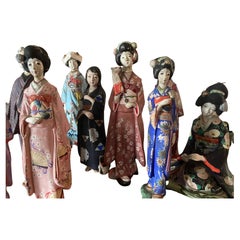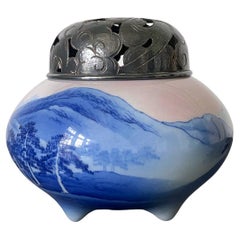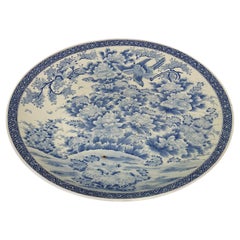MARPEVI Asian Art and Furniture
to
1
1
1
1
1
1
1
1
1
1
1
1
1
Japanese Figurines 1950s (9 pcs: 1 male and 8 females)
Located in Waddinxveen, ZH
An unique set of Japanese figurines of 9. Very decorative.
3 figurines are 25 cm high
5 are 22 cm high
And the sitting is 18 cm
Category
Vintage 1950s Japanese Japonisme Ceramics
Materials
Plaster, Ceramic
Related Items
Japanese Glazed Ceramic and Silver Koro Incense Burner Makuzu Kozan
By Makuzu Kozan
Located in Atlanta, GA
A tri-pod ceramic incense burner (koro) by Japanese Imperial potter Makuzu Kozan (1842-1916) circa late Meiji to the start of Taisho period (1890-1910s). A fine example of the artist's work belonging to the late part of his underglaze paint phase (started around 1887 until his death), the surface of the koro was painted in beautiful shades of blue to depict a continuous landscape not unlike a traditional ink and watercolor hand scroll. The rise and fall mountains recede and fade into the horizon and are dotted with groves of pines. The sky is painted with a beautiful subtle shade of pink, suggesting a time of sunrise or sunset. The koro is fitted with an ensuite reticulated sterling silver hoya (incense cover), pierced with swirling cloud and marked with "pure silver' in Kanji. The base is signed in underglaze blue "Makuzu Kozan Sei" within a double ring. The piece is beautifully potted in form and the decoration was done with expertise using the novel technique developed by Kozan called Fuki-e (the blow painting), in order to achieve the striking landscape known as "Mountain and Water" with sense of dimensions and gradient, the poetic effects normally conveyed only by sumi ink staining on paper. The piece comes with an unsigned tomobako (wood storage box) of a recent age.
Also known as Miyagawa Kozan (1842–1916), Makuzu Kozan was one of the most established and collected ceramist from Meiji Period. Born as Miyagawa Toranosuke, Kozan established his pottery studio in Yokohama around 1870s and later became one of the appointed artists to the Japanese Imperial household. His work was exhibited in many international fairs that the Meiji government participated at the turn of the century and won many grand prizes. Being one of the most creative ceramists, Kozan started experimenting with new chemical colors from the West in the format of his porcelain glaze around 1880s. New colors allowed him to create underglaze designs that appeared bright, smooth and glossy. He even invented his own receipt of cobalt blue to achieve a much brighter yet softer shade, as evident on this vase. To create landscape that is realistic and dimensional, more common in the western paintings, he was inspired by the native Japanese ink painting technique developed around 1900 by Yokoyama...
Category
Antique Early 1900s Japanese Japonisme Ceramics
Materials
Silver
Massive Antique Japanese Arita Porcelain Emperor Meiji
By Arita
Located in Hillringsberg, SE
This very large plate made in Japan during the Emperor Meiji time 1868-1912. Wonderful blue pattern on fine porcelain.
There is a crack that’s shown thro...
Category
Antique 19th Century Japanese Japonisme Ceramics
Materials
Ceramic
Japanese Black Lacquer Box Together with a Blue and White Arita Plate
Located in Ottawa, Ontario
2 drawers. Drop down top. A Japanese black lacquer box
Together with a blue and white Arita plate,
20th century
Lacquer box of rectangular form with b...
Category
20th Century Japanese Japonisme Lacquer
Materials
Ceramic, Lacquer
A Japanese Satsuma ceramic lobed bowl
Located in Milano, IT
Satsuma ceramic lobed bowl with curved corners and embellished with a refined scene of daily life along a watercourse on the outside. The interior is adorne...
Category
Antique Late 19th Century Japanese Japonisme Ceramics
Materials
Ceramic
Japanese Porcelain Plate
Located in Atlanta, GA
An Japanese porcelain plate circa 1930s-1940s. Decorated with over glaze featuring three ladies in waiting. In the garden, the rock grottoes, a cherry tree in blossom, a half hidden banana tree and a few peeking peonies, suggest a subtropical scenery. The ladies were pictured as holding various item, a fly...
Category
Early 20th Century Japanese Japonisme Ceramics
Materials
Ceramic
Japanese Satsuma Vase with Figures
Located in Antwerp, BE
A mid-20th century Japanese Satsuma vase with figures.
Satsuma ware is a style of Japanese earthenware originally from the Satsuma region of what is today southern Kyushu. There are two distinct categories of this ware: The original plain dark clay early Satsuma...
Category
Mid-20th Century Japanese Japonisme Vases
Materials
Ceramic
Japanese Antique Kakiemon Plate from Arita
Located in Atlanta, GA
A milky white dish with slight scalloped rim and decorated with cobalt blue iron red and green enamel over glaze, this delicate piece in Kakiemon Style was dated at least to the earl...
Category
Antique Early 18th Century Japanese Japonisme Ceramics
Materials
Porcelain
19th Century Japanese Satsuma Style Porcelain Tea Set 27pcs Pot Richly Decorated
Located in Amsterdam, Noord Holland
This add is for 27 pieces.
Unusual and very detailed pieces with butterfly in original box. Marked on base. Porcelain in Satsuma style
5-7-18-zwa-3114p
Condition:
Overall c...
Category
Early 20th Century Japanese Taisho Ceramics
Materials
Porcelain
H 0.04 in Dm 0.04 in
1920s Japanese Hand Painted and Gilded Demitasse Coffee Service
Located in Roma, IT
1920s Japanese Hand Painted and Gilded Demitasse Coffee Service
This exceptional 1920s Japanese coffee service features 6 demitasse cups with accompanying, coffee pot, sugar bowl an...
Category
Early 20th Century Japanese Japonisme Ceramics
Materials
Porcelain
Early Japanese Satsuma Antique Vase
By Satsuma
Located in Atlanta, GA
An Satsuma ceramic stone ware vase, circa 19th century, around the end of the Edo and the beginning of Meiji period. In the form of a Classic garlic bottle whose prototype was from China, the white bodied piece is decorated with an early form of kin nishikide, the so called golden brocade, a palette of iron-red, blue, green, yellow, purple and black with golden highlight. The over glazed enamel paint shows a group of robed figures in a garden setting with a lion and three tigers. A transparent overall glaze shows very fine crackles. The design is relatively sparse with plenty of negative space in contrast to the Satsuma production from the late 19th century, when the trend became fussy and overly glitz, due to the influence by the perceived western taste for the export market. This piece may still be made for export but its pattern was more influenced by both Kyoto Pottery and the Kano school of painting compared to the export ware by the end of the 19th century onward to the early 20th century. It was believed by many that this was a result of Satsuma potters visiting Kyoto in the late seventeenth century to learn over glaze painting techniques.
There are some age glaze crackles especially around the foot. The piece is not signed in keeping with the earlier production before Satsuma ceramics...
Category
Antique Mid-19th Century Japanese Japonisme Ceramics
Materials
Ceramic
Large Japanese Blue and White Vase by Mazuku Kozan Meiji Period
By Makuzu Kozan
Located in Atlanta, GA
A striking blue and white vase from the studio of Japanese Potter Makuzu Kozan, also known as Miyagawa Kozan (1842–1916), one of the most established and collected ceramist from Meiji Period. Born as Miyagawa Toranosuke, Kozan established his pottery studio in Yokohama around 1870s and later became one of the appointed artist to the Japanese Imperial household. His work was exhibited in many international fairs that the Meiji government participated at the turn of the century and won many grand prizes.
With a relative large size, this vase is decorated with underglaze cobalt blue using the novel technique developed by Kozan called Fuki-e (the blow painting), in order to achieve the striking dimensional misty winter landscape. The pine trees with upright trunks and down-sweeping branches appear receding into the depth of the mist, forming an visually unending forest. Known as one of the most creative ceramists, around 1880s, Kozan started experimenting with new chemical colors from the West in the format of his porcelain glaze. New colors allowed him to create underglaze design that appeared bright, smooth and glossy. He even invented his own receipt of cobalt blue to achieve a much brighter yet softer shade, as evident on this vase. To create landscape that is realistic and dimensional, more common in the western paintings, he was inspired by the native Japanese ink painting technique developed around 1900 by Yokoyama...
Category
Early 20th Century Japanese Japonisme Ceramics
Materials
Porcelain
Japanese Ceramic Sake Bottle Chosen Karatsu Ware
Located in Atlanta, GA
The long neck bottle of classic form was heavily potted with coarse clay with high iron content. The flask, circa 18th century Edo period, was purposed for sake storage but also substituted as a flower vase during tea ceremony. The surface is covered in glossy black glaze and contrasts strikingly with white ash glaze around the shoulder. The white, fired with straw, displays a splashing feather effect and fine crackles, blending in with the black artistically. This type of Karatsu ware...
Category
Antique 18th Century Japanese Japonisme Ceramics
Materials
Ceramic


